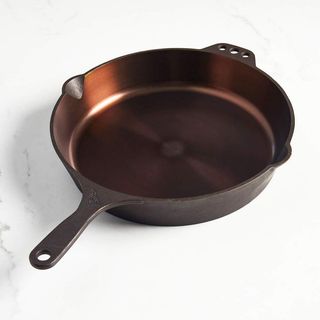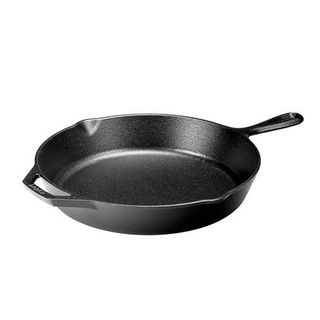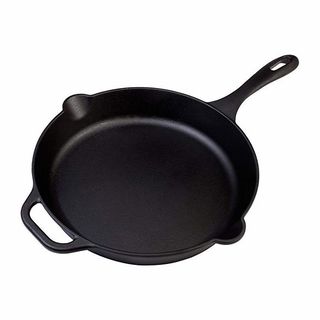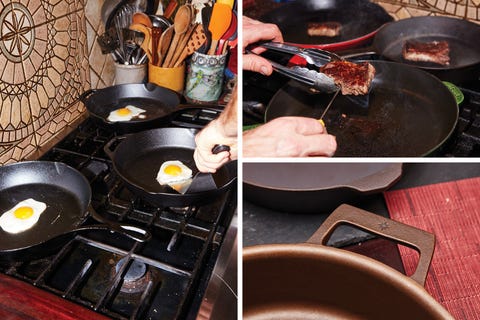Cast Iron Skillets Worth Money
The cast-iron skillet is the powerhouse of all kitchen equipment. Its non-stick surface is free of synthetic chemicals and will eventually require less oil than aluminum or stainless-steel pans. Cast iron has low thermal conductivity (meaning it doesn't heat as evenly), but it does offer superior heat retention, making it ideal for high-temperature cooking like searing steak or caramelizing veggies. It's also the only cookware you can buy that will improve with use. However, cast iron can be a serious investment, so we had cookbook author David Joachim test a bunch of skillets to help you select the best one for your kitchen.
Check out quick info below on the best five cast-iron skillets, then scroll deeper for buying info and full reviews of these models plus other top-performing options.
Best Performance

Smithey Ironware No. 12
Inspired by vintage cast iron, Smithey's polished skillet did the best overall in our testing.
Best Non-Stick

Stargazer 12-Inch
stargazercastiron.com
$145.00
The small-batch Stargazer brand creates a balanced skillet in terms of weight, performance, and price.
Best Everyday Skillet

Lodge Classic 12-Inch
It's hard to go wrong with this pan from the most well-known American cast-iron manufacturer.
Best Enameled

Le Creuset Signature Iron 11.75-Inch
Le Creuset lives up to its reputation as the maker of the finest French enameled cast-iron cookware.
Best Value

Victoria 12-inch
This inexpensive skillet outperformed others that cost more than eight times its price.
Should You Get New or Vintage Cast Iron?
Romanticizing the past often risks snubbing modern innovation, but the generalization that things were better back in the good ol' days may be true of the cast-iron skillet. That's because the cast iron found in your grandmother's kitchen or antique markets was likely hand-polished to create that coveted smooth surface. Polishing is time-consuming and expensive, so most of today's manufacturers leave the gritty texture from sand molds. Companies then have to compensate by pre-seasoning their pans to reduce stickiness.
You could search for vintage pans like Griswold and Wagner from antique shops or eBay, though there's risk you'll run into cracks or rust. But new high-quality cast iron can still provide that excellent nonstick surface that'll only get better with use as you increase its seasoning over time. Some premium manufacturers are even going back to time-tested manufacturing and polishing methods. With the right skillet and skills, you can build up the seasoning on your new pan to rival those you'd find at the flea market. Plus, you'll get more satisfaction (and can save money) by doing it yourself.
The Chemistry of Cast-Iron Seasoning
A quick internet search will reveal that just about everyone has a different opinion on how to season cast iron, but there's actual science behind the right methodology. This "seasoning" is really just polymerized oil, created through the chemical process of monomer molecules forming polymer chains. Applying a thin layer of oil and heating it above its smoke point (usually between 400 and 500 degrees) for up to an hour will vaporize lighter hydrocarbons, leaving heavier molecules to form a polymer on the iron.
Many experts—from Sheryl Canter to our tester David Joachim—advocate for the use of polyunsaturated oils, especially 100 percent flaxseed oil, because they contain double bonds with less hydrogen and more carbon components, allowing them to form larger polymers. Much like a drying oil you'd find in oil paint or varnishes in your workshop, flaxseed oil will also transform into a harder, tougher surface through oxidation. Because the hydrocarbon bonds are hydrophobic (or water-repelling), the surface will become slick and non-stick.
How to Properly Season and Care For Your Skillet
Cast iron has a reputation for being difficult to clean, but it doesn't actually have to be a challenge. While each brand may have distinct care instructions, you can follow Joachim's method of seasoning and tips for maintaining your cast iron.
- Warm up your cast iron to about 200 degrees on a stovetop.
- Rub a polyunsaturated fat, like 100 percent flaxseed oil, into the iron with a paper towel, leaving a thin sheen of oil.
- Place the pan upside down in the oven, heated to 500 degrees, and bake for one hour.
- Turn the oven off and let the pan cool completely for at least two hours.
- Repeat the process up to six times to achieve the thickest, most durable layer of seasoning.
To retain your seasoning, Joachim recommends avoiding acidic ingredients like vinegar, lemon juice, and tomatoes—though a quick deglaze with wine or vinegar is fine. When you clean it, avoid abrasive pads or cleaners like steel wool. Instead, let the pan cool a bit, then scrape with hot water and a wooden spoon or rinse with water and a soft sponge. Use dish soap sparingly because soap can dissolve the fat that makes up your seasoning. Then immediately wipe the pan dry so it doesn't rust, or dry it on low heat on the stovetop or in the oven.
How We Tested These Skillets
Cookbook author Joachim conducted a series of five tests on 10 skillets from reputable brands to judge their heat conductivity, heat distribution, smoothness, stickiness, and ergonomics. First, we measured smoothness by scraping a metal spatula over their surface and recording the decibel levels. We judged factory seasoning by frying an egg with no oil at medium heat. Using paper circles in the pans, we observed burn patterns to evaluate heat distribution. Then, we seared four-ounce boneless strip steaks to monitor speed, evenness, and depth of browning. Finally, we poured one cup of water from each pan to consider the ergonomics of the handle, pouring spouts, and weight. In addition to considering their value, we ranked each skillet from 1 to 10 (worst to best) on the stickiness, searing, heat distribution, and pouring tests.

Trevor Raab
—BEST PERFORMANCE—
Smithey Ironware No. 12
Weight: 8 lb | Diameter: 11.5 in. | Height: 2.25 in. | Handle length: 5.5 in. | Helper handle: 2.5 x 1.25 in. | dBa: 91.1 | Stickiness: 10 | Searing: 10 | Heat Distribution: 10 | Pouring: 4

Smithey
Smithey Ironware No. 12 Cast-Iron Skillet
$200.00 smithey.com
- Smooth, polished interior
- Heavy
One newer company taking inspiration from vintage pans, Smithey Ironware polishes the interior of its skillets to create a gorgeous, glassy surface. At eight pounds, the No. 12 skillet is the heaviest we tested, but its weight potentially contributed to its excellence in our searing and heat-distribution tests. Smithey's cast iron quickly delivered an even, dark sear, with no hotspots and very little sticking. Given it has such a high heat capacity, you'll have to ensure you regulate the temperature to avoid burning. Unfortunately, the small helper handle doesn't have a loop to assist with its weight. Instead, it features three holes that signify the Smithey brand.
—BEST NON-STICK—
Stargazer 12-Inch
Weight: 6.5 lb | Diameter: 12 in. | Height: 2 in. | Handle length: 7.5 in. | Helper handle: 3.75 x 2 in. | dBa: 70 | Stickiness: 10 | Searing: 8 | Heat Distribution: 9 | Pouring: 10

12-Inch Cast-Iron Skillet (Seasoned)
Stargazer stargazercastiron.com
$145.00
- Large helper handle
- Great non-stick seasoning
- Top of handle is uncomfortable
Compared to the offerings of Smithey and other more expensive brands, Stargazer's skillet is more balanced in its weight, heat conductivity, and heat distribution. Though it doesn't have any spouts, its pouring was still precise thanks to the unique rolled rim. With a long handle and large helper handle that you can even use while wearing an oven mitt, it's as comfortable as it is functional. The top of the handle dug a bit into our hands, but it's also designed to stay cooler longer, so it's worth it if you're accustomed to pan handles that don't conduct heat. You can get this skillet unseasoned or pre-seasoned, as well as in a 10.5-inch version.
—BEST EVERYDAY SKILLET—
Lodge Classic 12-Inch
Weight: 7.6 lb | Diameter: 12 in. | Height: 2.5 in. | Handle Length: 5 in. | Helper handle: 4 x 1.25 in. | dBa: 95.5 | Stickiness: 4 | Searing: 7 | Heat Distribution: 4 | Pouring: 5

Classic 12-Inch Cast-Iron Skillet
- Available anywhere
- Affordable
- Sticky and a bit heavy
- Long preheat time
The cast-iron brand that you can find just about anywhere, Lodge has been around for 120 years for a reason. The Classic 12-inch skillet doesn't necessarily exceed others at any particular task, but it's a popular and affordable choice that'll last for decades. Despite its heft verging on eight pounds, it's fairly well balanced. And even though it heats up slowly, it yielded a nice and even sear on our steak. Just be sure to use some extra cooking oil until the seasoning builds up more to prevent some sticking.
—BEST ENAMELED—
Le Creuset Signature Iron 11.75-Inch
Weight: 6.6 lb | Diameter: 11.75 in. | Height: 2 in. | Handle Length: 5.5 in. | Helper handle: 4 x 1.75 in. | dBa: 85.5 | Stickiness: 7 | Searing: 8 | Heat Distribution: 7 | Pouring: 6

Signature Iron 11.75-Inch Cast-Iron Skillet
Le Creuset chefsfirst.com
$547.99
- Smooth, colorful enamel
- Metal utensils may scratch the enamel
The high-end French Le Creuset label lived up to its reputation as the maker of the finest enameled cast-iron cookware. The matte black enameled interior is smooth, with little sticking, and the glossy enamel exterior is resistant to stains, durable, and available in plenty of color options. The skillet heated up relatively quickly and browned meat consistently. Along with solid performance, it has steady handling and a wide loop helper handle that's easy to use with an oven mitt.
—BEST VALUE—
Victoria 12-Inch
Weight: 7.4 lb | Diameter: 12 in. | Height: 2 in. | Handle Length: 7 in. | Helper handle: 4 x 1.5 in. | dBa: 80.5 | Stickiness: 3 | Searing: 9 | Heat Distribution: 8 | Pouring: 9

12-Inch Cast-Iron Skillet
Victoria amazon.com
$33.12
This Colombia-made skillet is often on sale for $30 or less, yet it outperformed some that cost more than six times its price. It may require some extra seasoning to improve its non-stick surface, since our egg stuck quite a bit with no oil. But overall, it supplied even heat distribution and a great, uniform sear. The long seven-inch handle is curved for better grasping, though the pan felt slightly front-heavy during our pouring test.
—MOST PREMIUM—
Butter Pat Joan 12-Inch
Weight: 6.4 lb | Diameter: 12 in. | Height: 2 in. | Handle Length: 5 in. | Helper handle: 4 x 1.12 in. | dBa: 82.7 | Stickiness: 9 | Searing: 9 | Heat distribution: 9 | Pouring: 9

Joan 12-Inch Cast-Iron Skillet
Butter Pat butterpatindustries.com
$295.00
- Smooth polish on all sides
- Most expensive
It's hard to justify spending roughly $300 on a skillet, but the Joan's capability just about warrants the hefty price. Butter Pat pans are cast thin and polished on all sides, making them relatively lightweight and good at heating evenly. The 12-inch Joan performed the most consistently well across all four of our testing categories. After a fast and even preheat time, it produced a very even and dark sear on our steak. We found that the underside of the handle dug into our hands a little but overall had decent balance and poured well from the rounded spouts. It may be one of the most expensive skillets out there, but the Joan is also the closest you can get to antique cast iron, if that's what you're looking for.
—SMOOTH ENAMEL—
Staub Enameled 12-Inch
Weight: 6.6 lb | Diameter: 12 in. | Height: 2.25 in. | Handle Length: 5.25 in. | Helper handle: 3 x 1 in. | dBa: 78.7 | Stickiness: 6 | Searing: 8 | Heat distribution: 6 | Pouring: 4

12-Inch Cast-Iron Fry Pan
Staub ajmadison.com
$189.99
- Smooth enamel
- Quick and even searing
- Pointed pour spouts may drip
- Some sticking and hot spots
In close competition with the Le Creuset, the Staub is another great enameled skillet made in France. And with similar searing capability, this 12-inch pan fell just behind with one hot spot during our heat distribution test and a bit of sticking while frying an egg. We also found its pointed pour spouts spilled more but were pleased with its smooth handle and balanced weight.
—UNIQUE DESIGN—
Finex 10-Inch
Weight: 5.8 lb | Diameter: 10 in. | Height: 2.25 in. | Handle Length: 6 in. | Helper handle: 2.5 x 1 in. | dBa: 77.3 | Stickiness: 3 | Searing: 9 | Heat distribution: 5 | Pouring: 7

10-Inch Cast-Iron Skillet with Lid
- Unique design and stay-cool handle
- High heat conductivity
- Thick handle
- Sticky
This Finex stands out from the crowd of round skillets with its octagonal design. Each corner acts as a pour spout, and the pan has a total diameter of 10 inches, with eight inches of cooking space. Though the surface felt very smooth, it was a bit sticky in our test. The skillet excelled at searing, but—like the Smithey—it has a high heat capacity that you'll need to watch to prevent burning. The coil around the handle helps keep it cool, but we found its diameter too large to get a good grip.
—LIGHTEST—
Lodge Blacklock 12-Inch
Weight: 5.8 lb | Diameter: 12 in. | Height: 2.5 in. | Handle Length: 6 in. | Helper handle: 4 x 1.25 in. | dBa: 91.4 | Stickiness: 5 | Searing: 8 | Heat distribution: 3 | Pouring: 1

Lodge Blacklock 12-Inch Cast-Iron Skillet
$79.95 williams-sonoma.com
- Lightest 12-inch skillet
- Long, curved handle
- Small spouts
- Uneven heat distribution
One of the latest skillets in Lodge's extensive lineup, the Blacklock, at under six pounds, rules as the lightest of all the 12-inch models we tested. It's a bit more expensive than the Classic Lodge but offers a longer, thinner, and curved handle. Our test results indicated that its shaved pounds may sacrifice a bit of evenness of heating. In addition, the small pour spouts caused quite a bit of dripping. But in the end, it generated a better dark brown sear than the Classic.
—SIMPLEST DESIGN—
Field No. 8
Weight: 4.2 lb | Diameter: 10 in. | Height: 2 in. | Handle Length: 5.5 in. | Helper handle: 2 x .75 in. | dBa: 76.3 | Stickiness: 4 | Searing: 7 | Heat distribution: 4 | Pouring: 1

Field No. 8 Cast-Iron Skillet
$125.00 fieldcompany.com
- Lightweight
- Well balanced
- Some hot spots and sticking
- No pour spouts
If you're looking for a cast-iron pan that's more portable, such as to transport to the campsite with you, we'd recommend this simple skillet from Field. By design, it lacks pour spouts, so it won't drip any grease into your campfire or grill. The Field looks smooth with a grape seed oil seasoning, but our egg stuck a bit. We also noticed some hotspots during our heat distribution tests, which resulted in slightly uneven, but still dark, searing. Though its helper handle is too small for practical use, its light and balanced weight means you don't really need help when carrying it anyway.
Paige Szmodis Paige Szmodis is an editor for Runner's World, Bicycling, and Popular Mechanics, who researches and writes home, tech, and outdoor product reviews and news.
This content is created and maintained by a third party, and imported onto this page to help users provide their email addresses. You may be able to find more information about this and similar content at piano.io
Cast Iron Skillets Worth Money
Source: https://www.popularmechanics.com/home/food-drink/a28493008/best-cast-iron-skillets/
Posted by: mejiaantum1964.blogspot.com

0 Response to "Cast Iron Skillets Worth Money"
Post a Comment